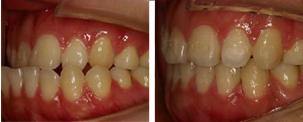Super cup, delay in treatment... Ah
If teeth with "reverse overjet" are corrected with an orthodontic appliance in childhood, 1000 yuan will be enough. However, if delayed until adulthood, the only option left is surgery which costs tens of thousands of yuan. Xiao Fang, aged 18, has become such a patient.
Xiao Fang is a lively and lovely girl with a pair of big watery eyes. Her face just looks a bit strange, with a particularly long jawbone. Her face appears to be crescent-shaped and concave inward, and when she smiles, her irregular teeth show up. Recently, after receiving her university admission notice, Xiao Fang decided to beautify herself before going to college by correcting her abnormal teeth. At the orthodontics department of the stomatological hospital, the doctor carefully examined Xiao Fang's teeth and found that they were a typical case of "reverse overjet", also known as "malocclusion". This condition severely affects the growth and development of the oral cavity, face, and jawbone, limiting the development of the middle third of the patient's face while causing excessive development of the lower third. As a result, the face appears moon-shaped from the side. The doctor regretfully informed Xiao Fang: "Malocclusion becomes more severe with age." She had missed the optimal correction period, and now the only way to correct it was through combined treatment involving maxillofacial surgery and orthodontics, at a cost of several ten thousand yuan. Xiao Fang's parents deeply regretted their decision upon hearing this. It turned out that when Xiao Fang was a child, her parents had taken her to see a doctor, but the dentist at the time mistakenly believed that orthodontic treatment could only begin around the age of 12 after all baby teeth had been replaced. Xiao Fang's parents incorrectly assumed that teeth straightening could be done at any time, so they planned to wait until her course load became lighter after entering university before starting the treatment. They never expected it to end up like this.
It is understood that the best time for correcting common dental malocclusions is around twelve or thirteen years old, which is when most baby teeth have been replaced. However, cases of malocclusion in baby teeth are relatively special and require early intervention. Parents should pay attention to observing the arrangement of their children's teeth and seek medical attention at a reputable stomatological hospital if any malocclusion deformities are detected.
